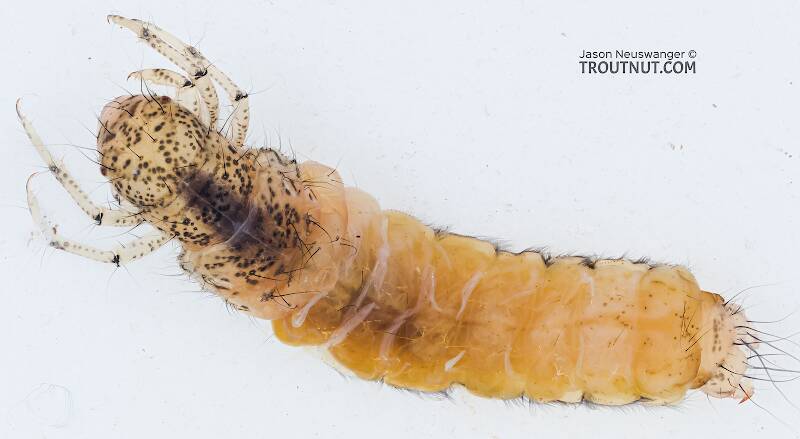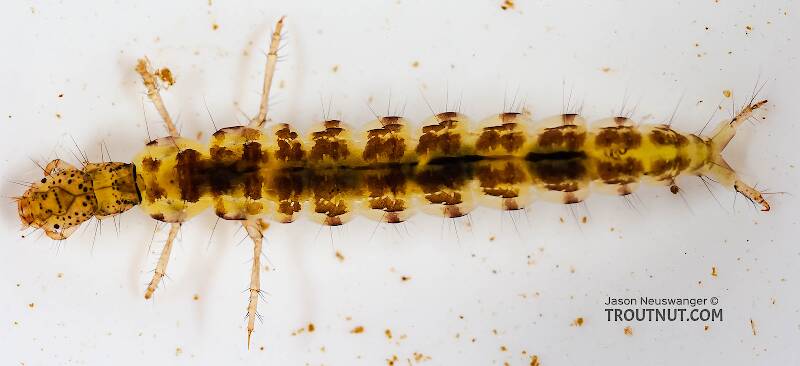
Salmonflies
Pteronarcys californica
The giant Salmonflies of the Western mountains are legendary for their proclivity to elicit consistent dry-fly action and ferocious strikes.
Featured on the forum

This is a striking caddis larva with an interesting color pattern on the head. Here are some characteristics I was able to see under the microscope, but could not easily expose for a picture:
- The prosternal horn is present.
- The mandible is clearly toothed, not formed into a uniform scraper blade.
- The seems to be only 2 major setae on the ventral edge of the hind femur.
- Chloride epithelia seem to be absent from the dorsal side of any abdominal segments.
Based on these characteristics and the ones more easily visible from the pictures, this seems to be Grammotaulius. The key's description of the case is spot-on: "Case cylindrical, made of longitudinally arranged sedge or similar leaves," as is the description of the markings on the head, "Dorsum of head light brownish yellow with numerous discrete, small, dark spots." The spot pattern on the head is a very good match to figure 19.312 of Merritt R.W., Cummins, K.W., and Berg, M.B. (2019). The species ID is based on Grammotaulius betteni being the only species of this genus known in Washington state.
- The prosternal horn is present.
- The mandible is clearly toothed, not formed into a uniform scraper blade.
- The seems to be only 2 major setae on the ventral edge of the hind femur.
- Chloride epithelia seem to be absent from the dorsal side of any abdominal segments.
Based on these characteristics and the ones more easily visible from the pictures, this seems to be Grammotaulius. The key's description of the case is spot-on: "Case cylindrical, made of longitudinally arranged sedge or similar leaves," as is the description of the markings on the head, "Dorsum of head light brownish yellow with numerous discrete, small, dark spots." The spot pattern on the head is a very good match to figure 19.312 of Merritt R.W., Cummins, K.W., and Berg, M.B. (2019). The species ID is based on Grammotaulius betteni being the only species of this genus known in Washington state.

Troutnut is a project started in 2003 by salmonid ecologist Jason "Troutnut" Neuswanger to help anglers and
fly tyers unabashedly embrace the entomological side of the sport. Learn more about Troutnut or
support the project for an enhanced experience here.
Identification: Key to Genera of Polycentropodidae Larvae
Identification: Key to Genera of Polycentropodidae Larvae
Error: Tried to access a key that isn't live.
Adapted from Merritt R.W., Cummins, K.W., and Berg, M.B. (2019)
This couplet refers figures (usually designated 'sf') from this source.
You will need the source (make sure to get the same edition!) to see them.
This couplet refers figures (usually designated 'sf') from this source.
You will need the source (make sure to get the same edition!) to see them.
| Option 1 | Option 2 |
|---|---|
| Anal claws each with 6 or fewer conspicuous teeth along ventral, concave margin (sf 19.387, 19.388) | Anal claws without ventral teeth (sf 19.389, 19.390, 19.392, 19.393) or each with 10 or more tiny spines (sf 19.391) along ventral, concave margin |
| Silken retreat forming rectangular tent over depression in wood or rock, open at two ends | |
| Remaining genera: Nyctiophylax and Polyplectropus | Remaining genera: Cernotina, Cyrnellus, Holocentropus, Neureclipsis, Plectrocnemia, and Polycentropus |
2 Example Specimens | |
| Go to Couplet 2 | Go to Couplet 3 |
Adapted from Merritt R.W., Cummins, K.W., and Berg, M.B. (2019)
The current couplet is highlighted with darker colors and a icon, and couplets leading to this point have a icon.
Couplet 1 (You are here)
Leads to Couplet 2:
- Anal claws each with 6 or fewer conspicuous teeth along ventral, concave margin (sf 19.387, 19.388)
- Silken retreat forming rectangular tent over depression in wood or rock, open at two ends
Couplet 2
Leads to Couplet 3:
- Anal claws without ventral teeth (sf 19.389, 19.390, 19.392, 19.393) or each with 10 or more tiny spines (sf 19.391) along ventral, concave margin
Couplet 3
Leads to Nyctiophylax:
- Teeth on anal claw much shorter than apical hook, dorsal accessory spine present (sf 19.65, 19.388)
- Pronotum with short, stout bristle near each lateral margin (sf 19.394)
- Widespread except not Southwest
Leads to Polyplectropus:
- Teeth on each anal claw almost as long as apical hook, dorsal accessory spine absent (sf 19.387)
- Pronotum without short, lateral bristles
- Southwest
Polyplectropus
Leads to Neureclipsis:
- Basal segment of each anal proleg about as long as distal segment and with only 2 or 3 apicoventral setae (sf 19.391)
- Anal claw with many tiny spines along ventral, concave margin (sf 19.391 inset)
- Larvae as in sf 10.167 Silken retreat trumpet-shaped, recurved, up to 12 cm long, slender basally and broad apically, with 3–4 cm opening facing current (sf 19.37) Widespread except not Southwest
Leads to Couplet 4:
- Basal segment of each anal proleg obviously longer than distal segment in mature specimens and with many setae scattered over most of its ventral and dorsal surfaces (sf 19.392, 19.393)
- Anal claw without tiny ventral spines (sf 19.392, 19.393)
Couplet 4
Leads to Couplet 5:
- Dorsal region between anal claw and sclerite of distal segment of each anal proleg with 2 dark bands contiguous mesally (sf 19.392 inset)
- Mesonotal sa1 and metanotal sa1 setae short, not more than 1/3 as long as longest sa2 setae (sf 19.397)
Couplet 5
Leads to Cyrnellus
(Cyrnellus fraternus):
(Cyrnellus fraternus):
- Dorsal region between anal claw and sclerite of distal segment of each anal proleg with 2 dark bands completely separated mesally (sf 19.393 inset)
- Mesonotal sa1 and metanotal sa1 setae about as long as longest sa2 setae (sf 19.398)
- Silken retreat similar to that of Nyctiophylax, but more nearly circular Central, East
Cyrnellus
(Cyrnellus fraternus)
(Cyrnellus fraternus)
Leads to Polycentropus:
- Prothoracic tarsi broad and only 1/2 as long as prothoracic tibiae (sf 19.395)
- Silken retreat bag-like structure expanded by current
Leads to Couplet 6:
- Prothoracic tarsi narrow and at least 2/3rds as long as prothoracic tibiae (sf 19.396)
Couplet 6
Leads to Plectrocnemia:
- Anal claws obtusely curved (sf 19.389)
- Capture net loosely constructed, flat, spider-like, with funnel-shaped silken retreat in middle, surrounded by maze of silken threads Widespread except not Southwest
Plectrocnemia
Leads to Couplet 7:
- Anal claws curved approximately 90º (sf 19.392)
Couplet 7
Leads to Holocentropus:
- Anal claws each with 2 or 3 dorsal accessory spines (sf 19.390, spines tiny and difficult to see with dissecting microscope, sometimes broken)
- Capture net bowl- or funnel-shaped with tubular retreat perpendicular to it in middle and supported by maze of silken threads in surrounding vegetation
- Central, North
Leads to Cernotina:
- Anal claws each with only 1 dorsal accessory spine (sf 19.392)
- Capture net silken, tent-like, covering depression in wood or rock, with flared opening at each end
- Central, East
Cernotina
Start a Discussion of this Couplet
References
- Merritt R.W., Cummins, K.W., and Berg, M.B. 2019. An Introduction to the Aquatic Insects of North America (Fifth Edition). Kendall/Hunt Publishing Company.



